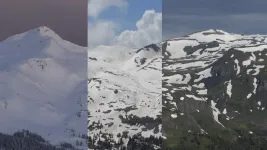(Press-News.org) CLAREMONT, CA - Keck Graduate Institute (KGI) Assistant Professor and University of California, Berkeley Visiting Scientist Dr. Kiana Aran first introduced the CRISPR-Chip technology in 2019. Now just two years later, she has expanded on its application to develop CRISPR-SNP-Chip, which enables detection of single point mutations without amplification in Sickle Cell Disease and Amyotrophic lateral sclerosis (ALS).
"The field of CRISPR-based diagnostics is rapidly evolving due to CRISPR programmability and ease of use," Aran says. "However, the majority of CRISPR-based diagnostics platforms are still relying on target amplifications or optical detections. The reprogrammability of CRISPR combined with optics-free highly scalable graphene transistors will allow us to bring the diagnostics power of the CRISPR to its full potential.
"The ability to detect single nucleotide polymorphisms (SNPs) is at the core of human health genetics but detection of SNPs is also very important in pharmacology, and agriculture, and is a driving force in evolutionary change such as mutations conferring resistance to antibiotics. Eliminating the need for amplification and optics will make SNP genotyping readily accessible."
Aran led the research team responsible for the work described in the paper "CRISPR-based Transistors for Amplification-free Electronic Detection of Single Point Mutations," to be published in the journal Nature Biomedical Engineering on April 5, 2021 (https://www.nature.com/articles/s41551-021-00706-z). It was a collaborative effort between Cardea Bio, KGI, UC Berkeley, UC Irvine, Vilnius University, and CasZyme.
The SNP-Chip technology is an extension of previously reported CRISPR-ChipTM, a technology that is capable of detecting large insertion and deletions. It earned a spot on the cover of Nature Biomedical Engineering in June 2019.
With graphene transistors, the authors now utilized a few versions of CAS enzymes and gRNA designs and monitored various different electrical signals obtained from graphene transistors to construct a new version of CRISPR-ChipTM, which ultimately enabled SNP detection without amplification. The newly developed CRISPR-Chip set, called SNP-Chip, is another major milestone in reshaping nucleic-acid-based detection methods.
"Merging a diversity of CRISPR-Cas biology with electronics via Cardean Transistors opens up a whole new range of possibilities for diagnostic applications, "said Dr. Virginjus Siksnys, founder and chairman of the CasZyme management board, professor at Vilnius University, Lithuania, and co-author on the paper. "Using the Cas9 orthologue for SNP detection is just the tip of the iceberg."
In this article, the utility of SNP-Chip was validated for testing SNP mutation in samples obtained from patients with Sickle Cell Disease and ALS. In both of these clinical models, the platform was able to discriminate healthy from mutated gene within the whole human genome without amplification and by simple swapping of gRNA to target desired DNA sequences indicating the ease of platform reconfiguration for different DNA targets.
SNP-Chip has the potential to greatly impact medical diagnostics and basic research as it can dramatically reduce the time and cost of SNP geotyping, monitor the efficiency of gRNA designs, and facilitate the quality control process involved in CRISPR-based gene editing.
"SNP-Chip's digital, direct, rapid, and accurate SNP analysis will revolutionize the screening for genetic mutations," said Irina Conboy, PhD, Professor of Bioengineering at UC Berkeley and co-author on the paper. "This new technology will inform the discovery of processes underlying disease and aging and will enable faster, more effective clinical translation."
Amplification-free detection of a target gene with single nucleotide mismatch specificity has the potential to streamline genetic research and diagnostics. Furthermore, it would provide more flexibility for biosensing applications previously confined to a laboratory setting.
INFORMATION:
Co-authors on the paper also include KGI's Sarah Balderston, Kandace Fung, Kasey Smith, Reza Hajian, UC Berkeley's Daehwan Kim and Irina M. Conboy, Cardea Bio's Elizabeth Celaya, Jonathan Parkinson, Ken Dickerson, Juan-Jose Ripoll, Regis Peytavi, Francie Barron, and Brett Goldsmith, UC Irvine's Jeffrey Taulbee and Philip Collins, CasZyme's Simonas Kutanovas, and Vilnius University's Giedrius Gasiunas and Virginijus Siksnys.
This work was fully supported by Cardea Bio as sponsored research to KGI.
About the Keck Graduate Institute (KGI)
KGI was founded in 1997 as the first higher education institution in the United States dedicated exclusively to education and research related to the applied life sciences. KGI offers innovative postgraduate degrees and certificates that integrate life and health sciences, business, pharmacy, engineering, and genetics, with a focus on industry projects, hands-on industry experiences, and team collaboration.
A member of The Claremont Colleges, KGI employs an entrepreneurial approach and industry connections that provide pathways for students to become leaders within healthcare and the applied life sciences. KGI consists of four schools: Henry E. Riggs School of Applied Life Sciences, School of Medicine, School of Pharmacy and Health Sciences, and the Minerva Schools at KGI. For more information, follow KGI on Twitter, Facebook, LinkedIn, and Instagram.
A new study, out this week, could pave the way to revolutionary, transparent electronics.
Such see-through devices could potentially be integrated in glass, in flexible displays and in smart contact lenses, bringing to life futuristic devices that seem like the product of science fiction.
For several decades, researchers have sought a new class of electronics based on semiconducting oxides, whose optical transparency could enable these fully-transparent electronics.
Oxide-based devices could also find use in power electronics and communication technology, reducing the carbon footprint of our utility networks.
A RMIT-led team has now introduced ultrathin beta-tellurite to the two-dimensional (2D) semiconducting material family, providing ...
Irvine, Calif. -- In 2019, the National Weather Service in Alaska reported spotting the first-known lightning strikes within 300 miles of the North Pole. Lightning strikes are almost unheard of above the Arctic Circle, but scientists led by researchers at the University of California, Irvine have published new research in the journal Nature Climate Change detailing how Arctic lightning strikes stand to increase by about 100 percent over northern lands by the end of the century as the climate continues warming.
"We projected how lightning in high-latitude boreal forests and Arctic ...
An interdisciplinary team led by KU Leuven and Stanford has identified 76 overlapping genetic locations that shape both our face and our brain. What the researchers didn't find is evidence that this genetic overlap also predicts someone's behavioural-cognitive traits or risk of conditions such as Alzheimer's disease. This means that the findings help to debunk several persistent pseudoscientific claims about what our face reveals about us.
There were already indications of a genetic link between the shape of our face and that of our brain, says Professor Peter Claes from the Laboratory for Imaging Genetics at KU Leuven, who is the joint senior author of the study with Professor Joanna Wysocka from the ...
Journal Name: Nature Methods
Title of the Article: Discovering multiple types of DNA methylation from individual bacteria and microbiome using nanopore sequencing
Corresponding Author: Gang Fang, PhD
Bottom Line:
Bacterial DNA methylation occurs at diverse sequence contexts and plays important functional roles in cellular defense and gene regulation. An increasing number of studies have reported that bacterial DNA methylation has important roles affecting clinically relevant phenotypes such as virulence, host colonization, sporulation, biofilm formation, among others.
Bacterial methylomes contain three ...
What The Study Did: A clinical risk assessment tool developed in China was tested with a group of patients in Spain to evaluate its ability to predict critical illness among patients hospitalized with COVID-19 in Europe.
Authors: Oscar Moreno-Perez, M.D., Ph.D., of the Alicante General University Hospital-Alicante Institute of Sanitary and Biomedical Research in Alicante, Spain, is the corresponding author.
To access the embargoed study: Visit our For The Media website at this link https://media.jamanetwork.com/
(doi:10.1001/jamainternmed.2021.0491)
Editor's Note: The article includes conflicts of interest disclosures. Please see the article for additional information, including other authors, author contributions and affiliations, conflict of interest and financial disclosures, and ...
What The Study Did: The 30-day incidence of outpatient and hospital-associated blood clots following SARS-CoV-2 testing among adults in a large health system was examined in this study.
Authors: Nareg H. Roubinian, M.D., of Kaiser Permanente Northern California in Oakland, is the corresponding author.
To access the embargoed study: Visit our For The Media website at this link https://media.jamanetwork.com/
(doi:10.1001/jamainternmed.2021.0488)
Editor's Note: The article includes conflicts of interest and funding/support disclosures. Please see the article for additional information, ...
What The Study Did: Researchers investigated the association of sociodemographic factors and blood group type with the risk of SARS-CoV-2 infection and severity of COVID-19.
Authors: Jeffrey L. Anderson, M.D., of the Intermountain Medical Center Heart Institute in Salt Lake City, is the corresponding author.
To access the embargoed study: Visit our For The Media website at this link https://media.jamanetwork.com/
(doi:10.1001/jamanetworkopen.2021.7429)
Editor's Note: The article includes conflicts of interest disclosures. Please see the ...
What The Study Did: Electronic health record data were used to examine whether the transition to remote cardiology clinic visits during COVID-19 is associated with disparities in patient use of care, diagnostic test ordering and medication prescribing.
Authors: Neal Yuan, M.D., of Cedars-Sinai Medical Center in Los Angeles, is the corresponding author.
To access the embargoed study: Visit our For The Media website at this link https://media.jamanetwork.com/
(doi:10.1001/jamanetworkopen.2021.4157)
Editor's Note: The article includes conflicts of interest and funding/support disclosures. Please see the article for additional information, including other authors, author ...
More snow is melting during winter across the West, a concerning trend that could impact everything from ski conditions to fire danger and agriculture, according to a new University of Colorado Boulder analysis of 40 years of data.
Researchers found that since the late 1970s, winter's boundary with spring has been slowly disappearing, with one-third of 1,065 snow measurement stations from the Mexican border to the Alaskan Arctic recording increasing winter snowmelt. While stations with significant melt increases have recorded them mostly in November and March, the researchers found that melt is increasing in all cold season ...
Three years ago, scientists at the University of Michigan discovered an artificial photosynthesis device made of silicon and gallium nitride (Si/GaN) that harnesses sunlight into carbon-free hydrogen for fuel cells with twice the efficiency and stability of some previous technologies.
Now, scientists at the Department of Energy's (DOE's) Lawrence Berkeley National Laboratory (Berkeley Lab) - in collaboration with the University of Michigan and Lawrence Livermore National Laboratory (LLNL) - have uncovered a surprising, self-improving property in Si/GaN that contributes to the material's highly efficient and stable performance ...



